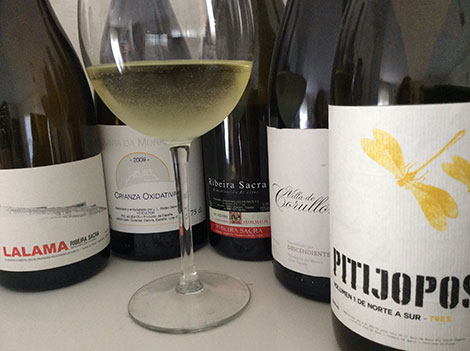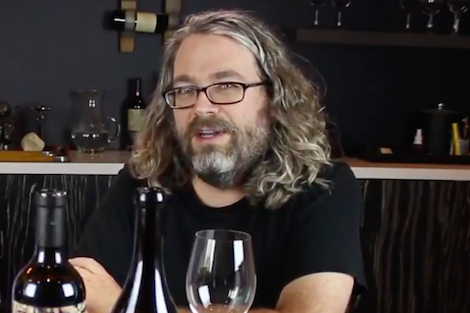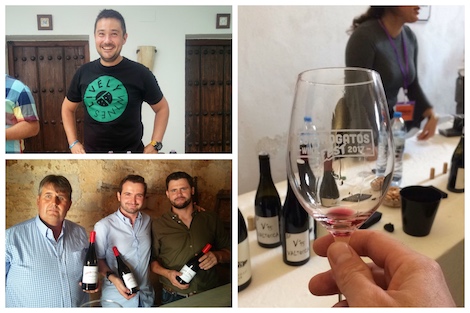
Garnacha and Mencía have filled wine lovers’ glasses for some time, but pet nats and unfortified Palomino have not been prominent outside of the tables of trade professionals, critics and wine geeks. Many of these styles are produced in tiny quantities, yet they are highly relevant given their ability to influence other producers and generate interest on an international basis.
Garnacha and Mencía, new Spanish red ambassadors
After Tempranillo’s massive expansion –and subsequent fatigue– beyond its natural enclaves, Mencía and Garnacha could very well become the next Spanish red stars. Mencía, which is geographically located in the northwest, displays original, distinctive and easily recognisable flavours. Unsurprisingly, Garnacha is widely present across the country (and the rest of the world) given its approachable, smooth, sexy character and its chameleonic ability to reflect a great diversity of soils and landscapes. Additionally, it has rich genetics (White, Gris and Hairy mutations), not to mention its low pH, increasingly used to freshen up blends.
Both varieties fit well with the general trend towards easy-drinking, less structured reds. On April, Spain will take centre stage as Terra Alta (Catalonia) hosts the sixth edition of Grenaches du Monde international wine competition.
With regards to Mencía, we are looking forward to see progress in Bierzo’s Burgundy-inspired classification as it could provide a major boost both for the grape variety and the region.
Atlantic-style reds from Galicia
As the spectrum of varieties starts to open up, Atlantic-style reds (light, fresh, aromatic wines with distinctive herbal nuances and wild crisp fruit) are gaining popularity. Galicia is undisputedly spearheading the trend, even though the style has also been adopted in parts of Tenerife and other high-elevation vineyards in different areas of Spain.
Who can forget those images of endless rows of steep Mencía vineyards on the hillsides of Ribera Sacra plunging down to the river? Other appellations like Ribeiro, Valdeorras, Monterrei and even Rías Baixas, usually associated to whites, also produce some lovely Atlantic-style reds. It’s also encouraging that some Rías Baixas producers (Zárate, Nanclares, Forjas del Salnés among others) are now making reds in Ribera Sacra. Winemaker and consultant Raúl Pérez, the driving force behind the style, still plays a highly influential role.
The charm of the Canary and Balearic islands
Natural isolation has proven to be a highly effective way to preserve local heritage. This is particularly evident in the Canary Islands with its amazing wealth of grape varieties, volcanic soils ("volcanic wines" are a sought-after category), the marked differences in elevation, particularly in Tenerife and La Palma, and the real charm of traditional farming techniques such as cordón trenzado. The best Canary Island wines are a breath of fresh air to top-class wine lists and are championed by influential sommeliers all over the world. Anyone who has the chance to try the wines of Envínate, Suertes del Marqués or Borja Pérez experiences this fascination and feels the wines’s expressiveness.
Their indigenous grape varieties (the most obscure and unknown are being recovered) and tourist appeal should turn the Balearic Islands into a source of Mediterranean inspiration. Although local demand makes it hard to find some of the wines outside of the archipelago, Majorca’s wine scene (we’ll be writing about this soon) is pretty exciting with new producers and important investments resulting in a wide range of wines and styles.
Unfortified Palomino
These wines encapsulate the efforts of a new generation of producers in the Sherry Triangle led by winemakers like Willy Pérez, whose Barajuela wines are a major study in wine making techniques and styles, and Ramiro Ibáñez with his terroir-driven observations bottled with the name of Pitijopos. In both cases, the focus is on the vineyards to bring to light the marked personality of the region’s crus as opposed to traditional Sherries, which are marked by the ageing process. As Willy Pérez puts it, "blends can be copied, but albariza (as the region’s chalky soils are known) is inimitable." The trend has already spread to the neighboring Montilla, the other signature region in Andalucía for fortified wines, where Pedro Ximénez is widely grown.
Sherry-inspired wines
Jerez has also become a source of inspiration for winemakers all over Spain. As we wrote a few months ago, we’re seeing more wines with flor and/or aged in Sherry casks outside of the Sherry Triangle as well as a resurgence of oxidative styles. In some cases the model is not Jerez but Jura. Biologically aged wines on the other hand fit in with the philosophy of producers who call for little intervention.
Whites in red wine producing regions
Beyond white specialist areas, the growing demand for white wines has led producers all over Spanish to explore this field, even in appellations with very little presence of white grape varieties in their vineyards.
Boasting a growing number of styles, terroirs and blends, Rioja is trying to get a foot on the white ladder. In Ribera del Duero, where white wines are not authorized to show the appellation seal, there’s a handful of limited production wines made from Albillo. And Priorat, with less than 100 hectares of white vines, has become a source of original whites. The fact that many of these new wines are backed by well-known terroir-focused producers adds value to the trend.
Terroir-driven wines all over
Compared with other traditional producers like France and Italy, Spanish appellations are particularly large. It’s almost impossible to generalize about the quality of a vintage in regions like Rioja or Ribera del Duero stretching 100 or more kilometres along the Ebro and Duero rivers respectively. Blending grapes from different areas is no longer the only way to make high-quality wines — as Burgundy’s philosophy has been enthusiastically adopted in Spain, we are witnessing an upsurge of new and fascinating expressions of very specific terroirs. Producers –this has been a key trend in Spain over the last two years– also want to state the origin on their labels. So with or without the approval of Regulatory Boards, village, lieu-dit and single-vineyard wines are a reality in most Spanish wine producing regions.
Low pH and long-cycle grape varieties
Spain grows many grape varieties which are well-equipped to face climate change. Take Bobal in southeast Spain (very low pH and even suitable to make sparkling wines) or old vine Cariñena, a once vilified and underrated variety in Rioja and Priorat which is now an important element in single-varietal wines. Less widely grown varieties like Graciano are emerging as a source of freshness and longevity in Rioja reds and to freshen up Tempranillo-based wines in southern areas of Spain.
After making a comeback in the DO Penedès, Sumoll is now used by a good deal of young producers in the region. In Spain’s southeast, Garnacha Tintorera is increasingly trusted to add punch and vivacity in reds while Mandó can help to make fresh reds in Valencia and the acidic, low pH Moravia Agria is generating increasing interest in Manchuela. Ancestral grape varieties that fell out of fashion have the attributes to fight climate change as Torres has demonstrated after an extensive research of varieties that were almost extinct in Catalonia.
Ancestral-method wines
Compared with traditional method sparkling wines like Cava or Champagne which undergo a second fermentation in bottle, pet nats are easier to make and resonate with natural, low-intervention winemaking styles. Fermentation starts in vats and finishes in the bottle without dosage. Most of these wines exhibit fun, irreverent and humorous labels. This style is particularly popular in Catalonia with producers like Loxarel, La Salada, Can Ramón or Vinyes Singulars, but it is fast spreading to other areas (we recently tasted a really interesting Verdejo pet nat made by Microbio Wines in Castilla y Léón). In our view these wines are a fantastic stepping stone for young wine consumers.
Recovering traditional styles with an international appeal
At a time when authenticity and differentiation are sought after values, Spain has plenty of traditional wines to contribute with. Some of them, such as clarete (a rosé made by mixing white and red grapes) or Catalunya’s brisados (skin-contact whites) go well with the current rosé and orange wine trend. As our US correspondent Bill Ward reminded us recently, the market is thirsty for good stories. Some that come to mind are rancio wines, Alicante’s sweet Fondillón, Malvasía or any brave recovery of almost extinct wines like sweet supurao in Rioja.
Spain appears in numerous wine predictions for 2018. In the US, Punch Drink senior editor Jon Bonné wrote a few days ago that it might finally exist a context “for a new generation to fall in love with Spanish wine, in a completely different mode from 15 years ago.” Meanwhile, American journalist Elin McCoy thinks that 2018 is the year to rediscover Spain. “A new generation of vignerons is bringing change to every region there, including classic Rioja, and creating reds and whites from such places as Ribeira Sacra and the Gredos mountains with character and quality at bargain prices,” she wrote for Bloomberg. Let’s not miss the opportunity.

Amaya Cervera
A wine journalist with almost 30 years' experience, she is the founder of the award-winning Spanish Wine Lover website. In 2023, she won the National Gastronomy Award for Gastronomic Communication
Wine tastings in February 2018
NEWSLETTER
Join our community of Spanish wine lovers






